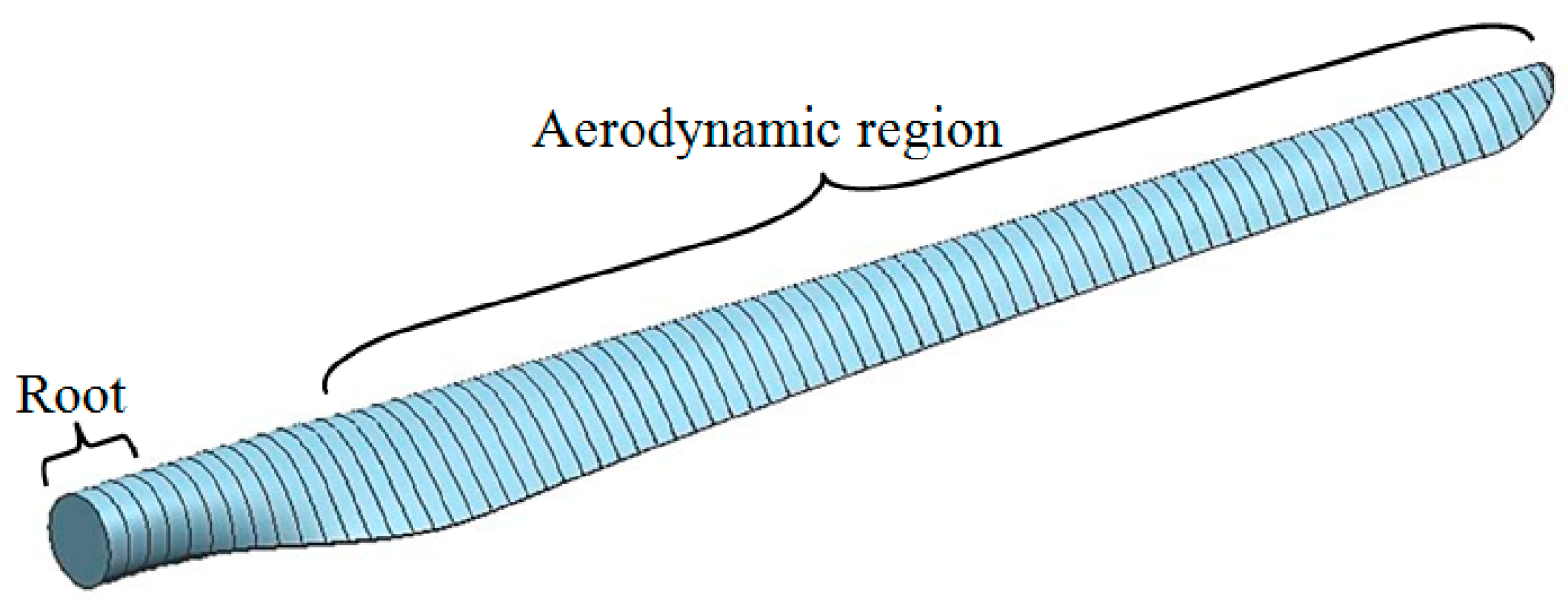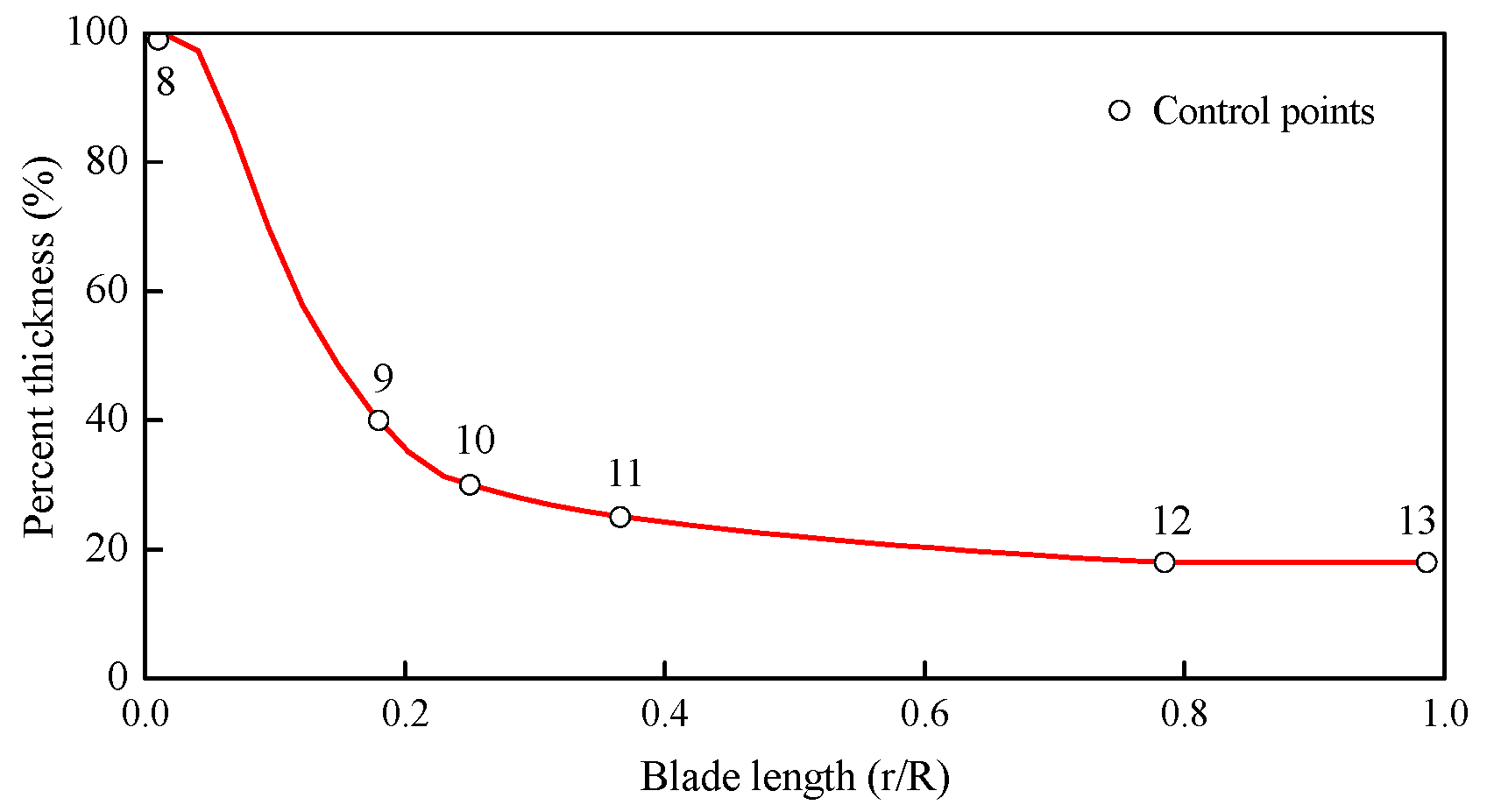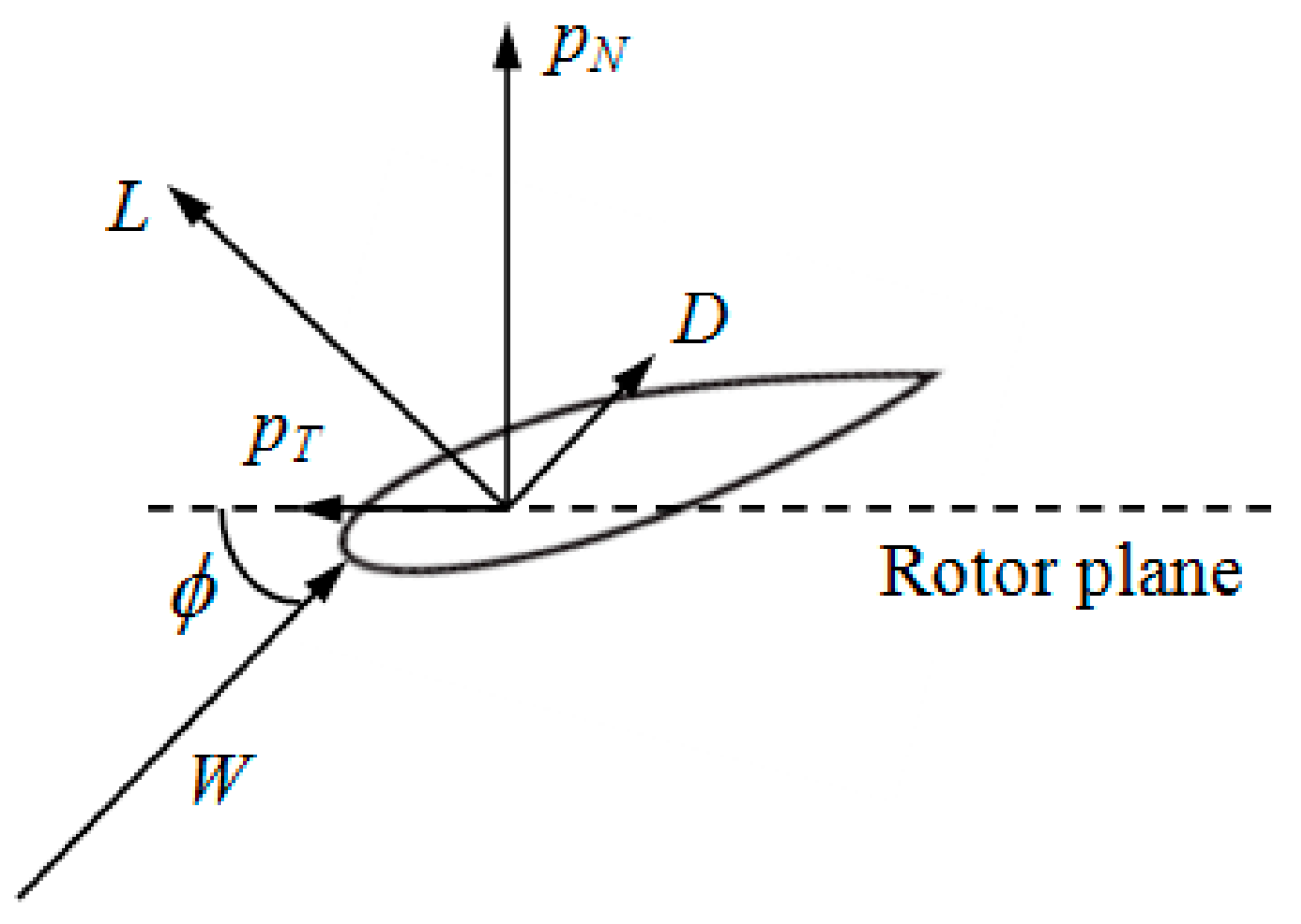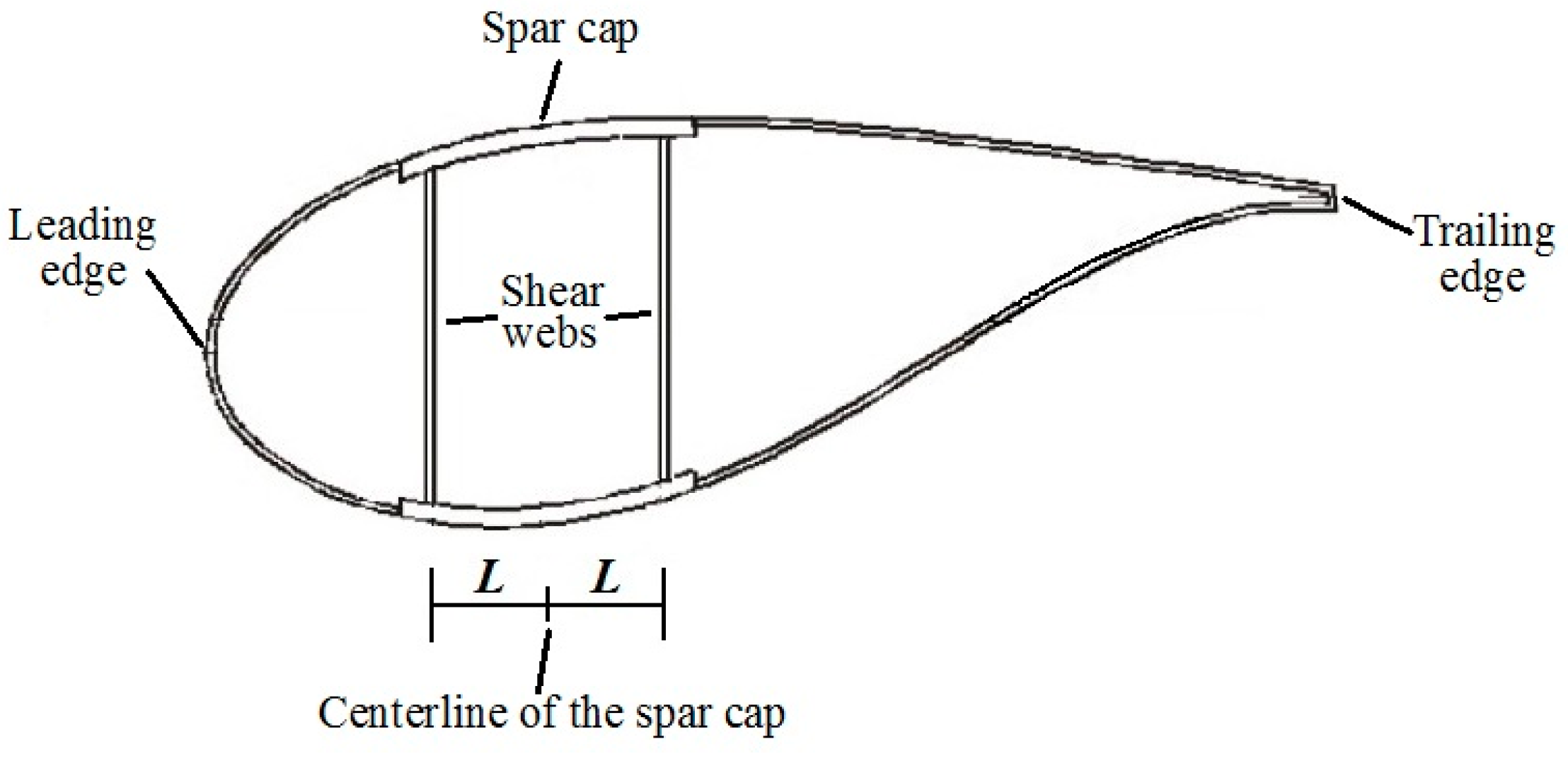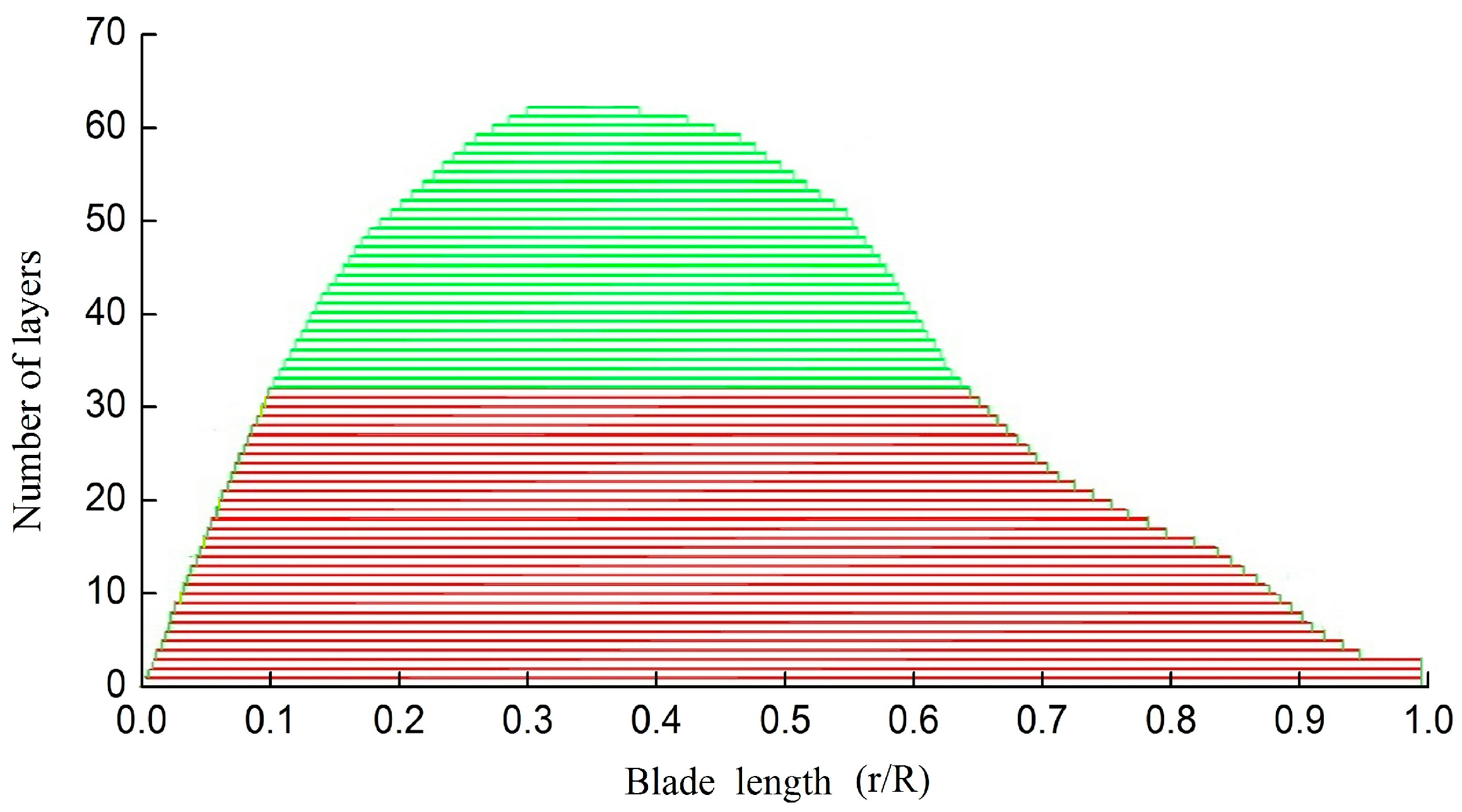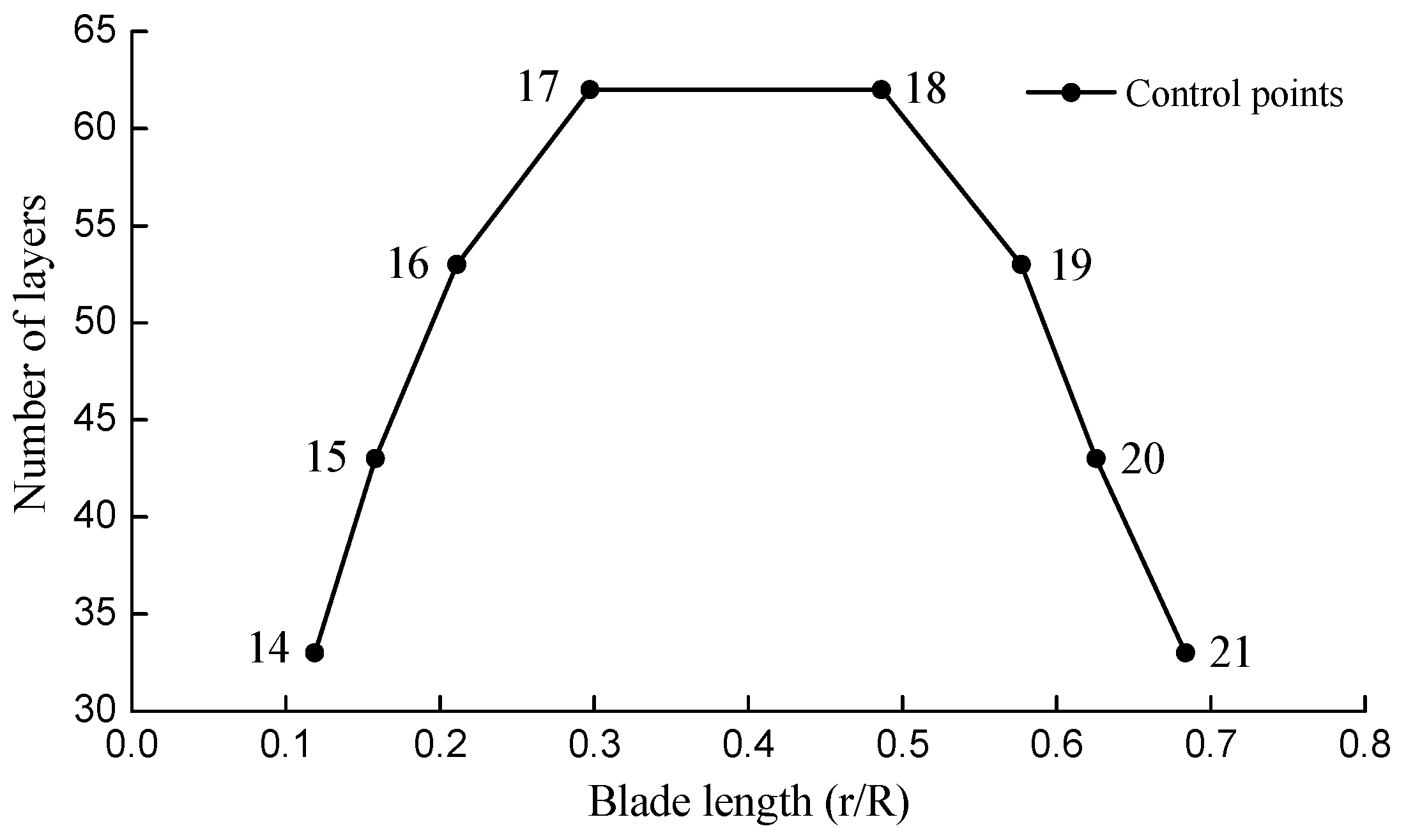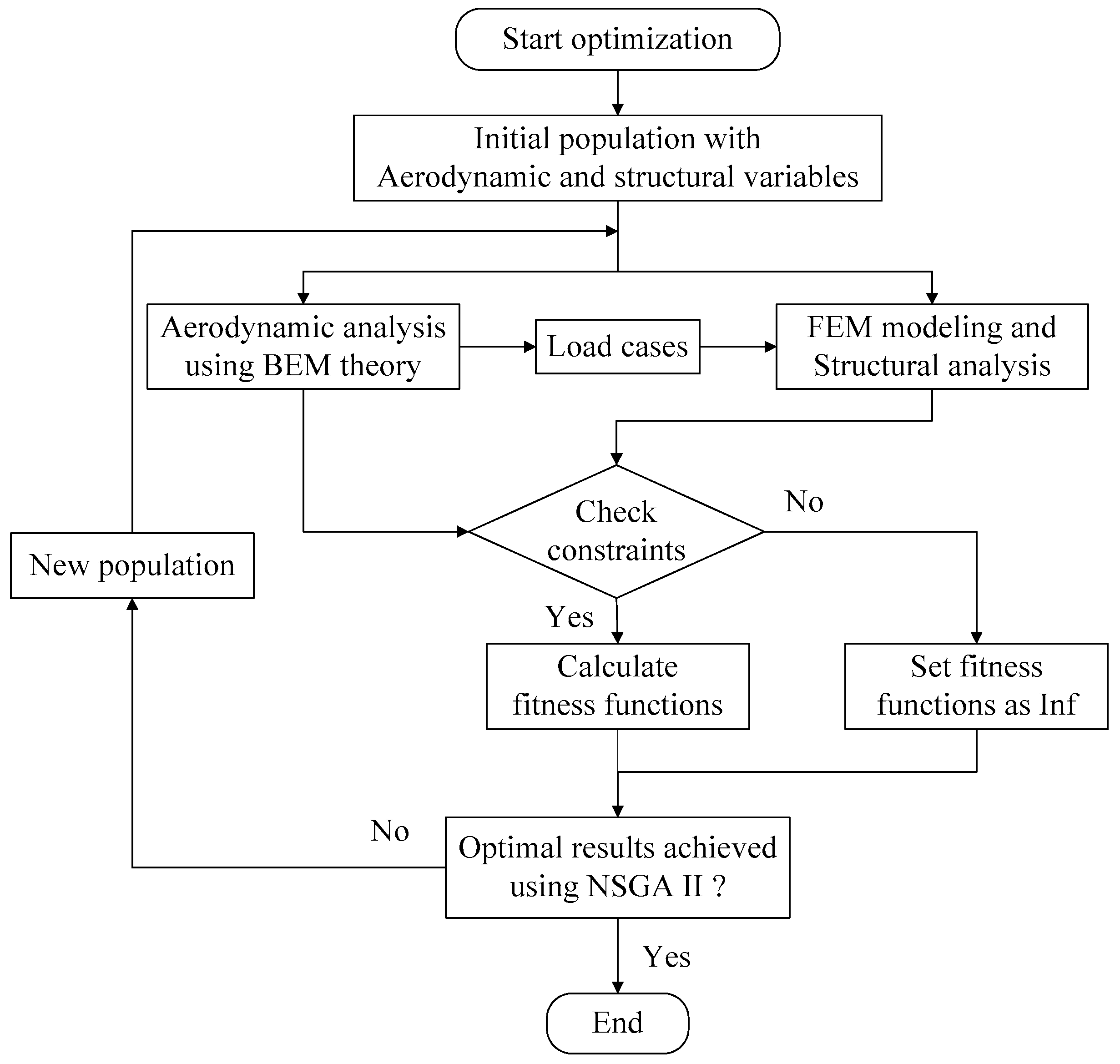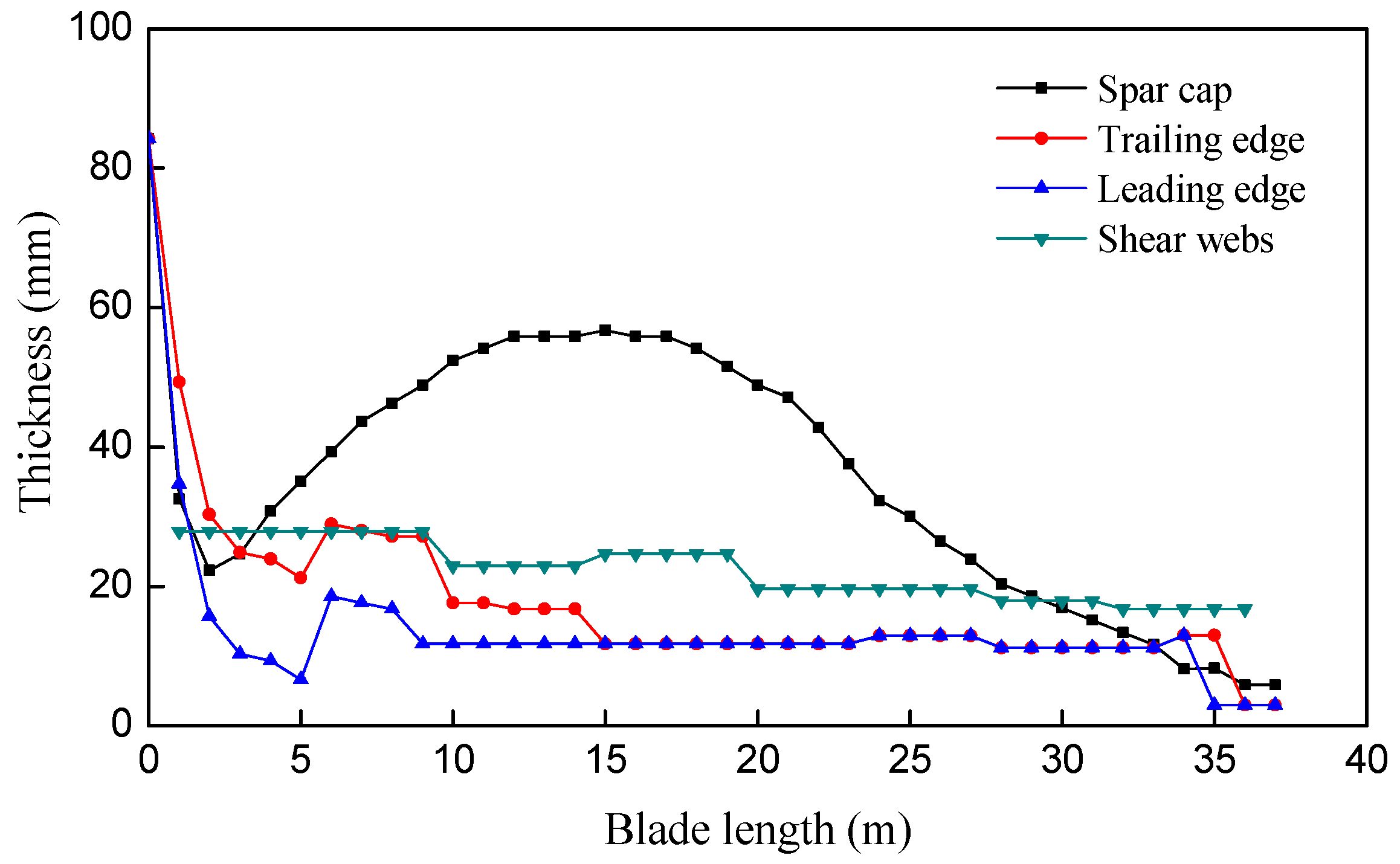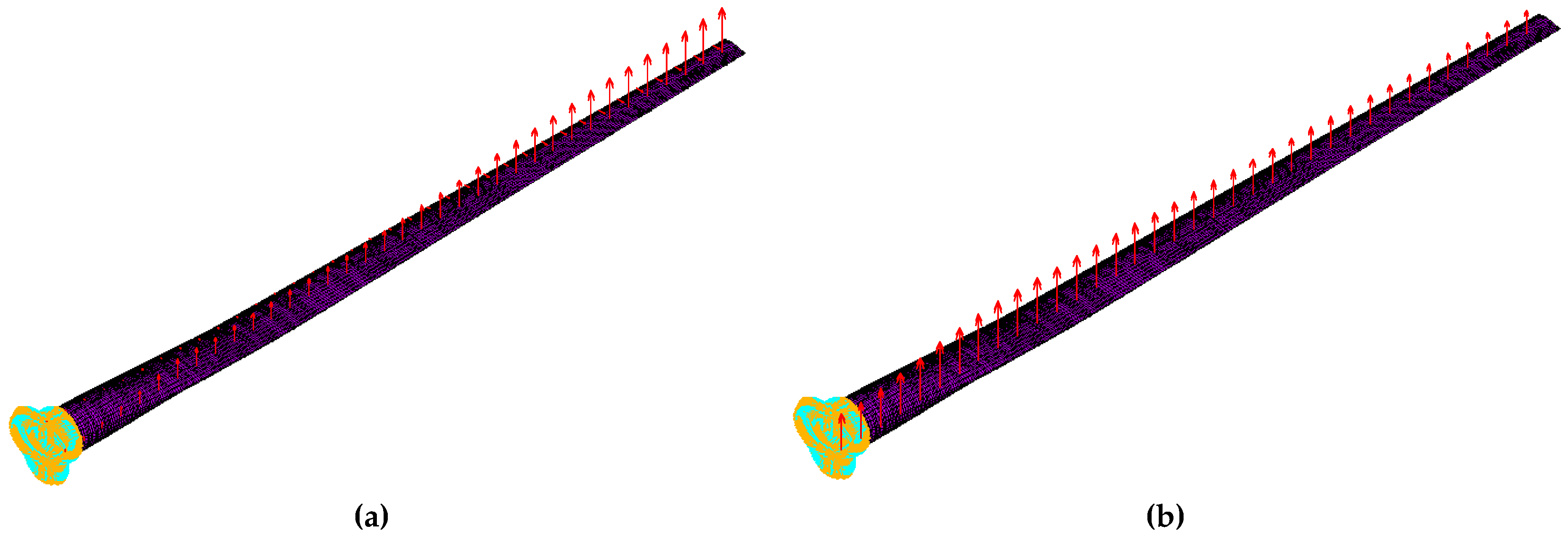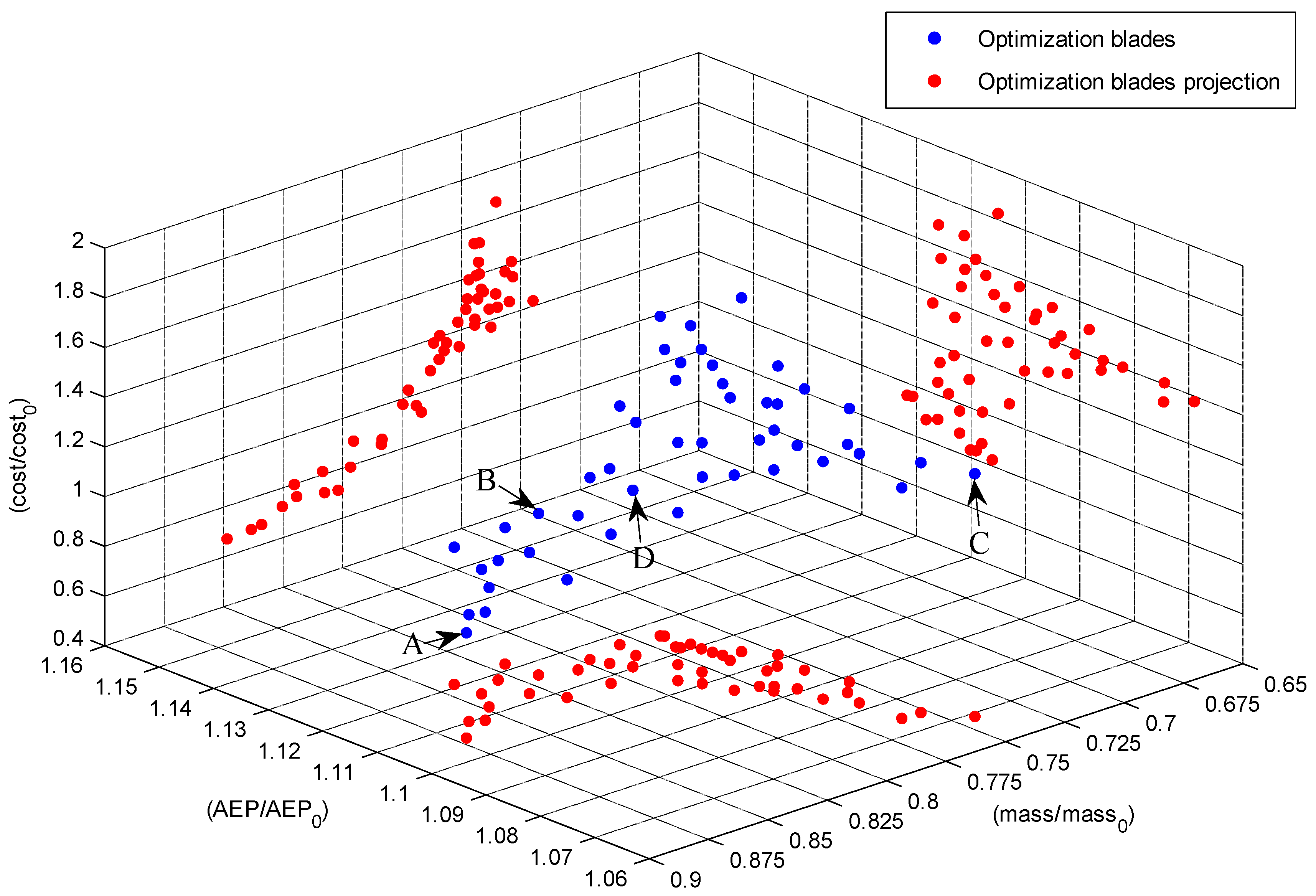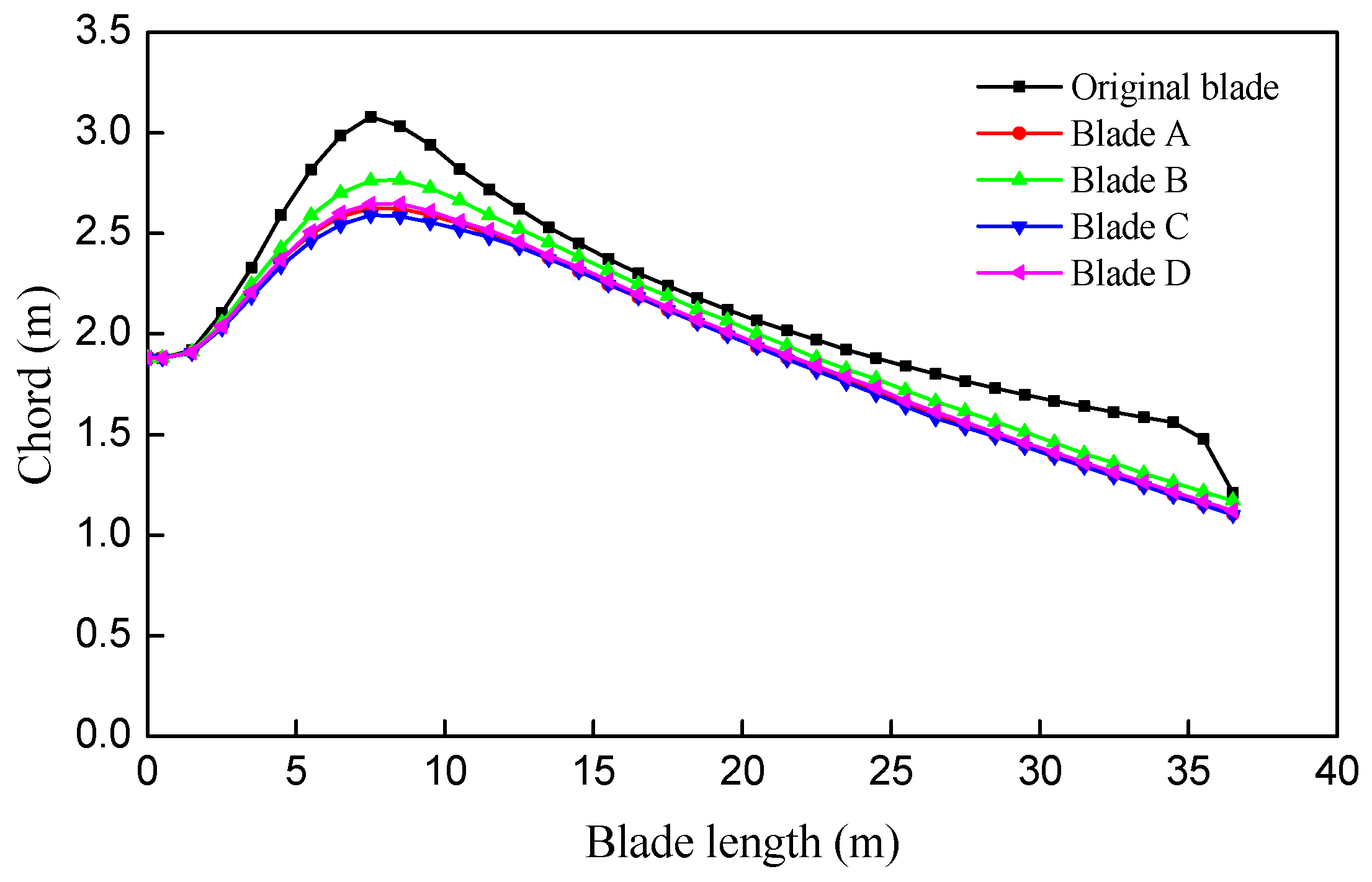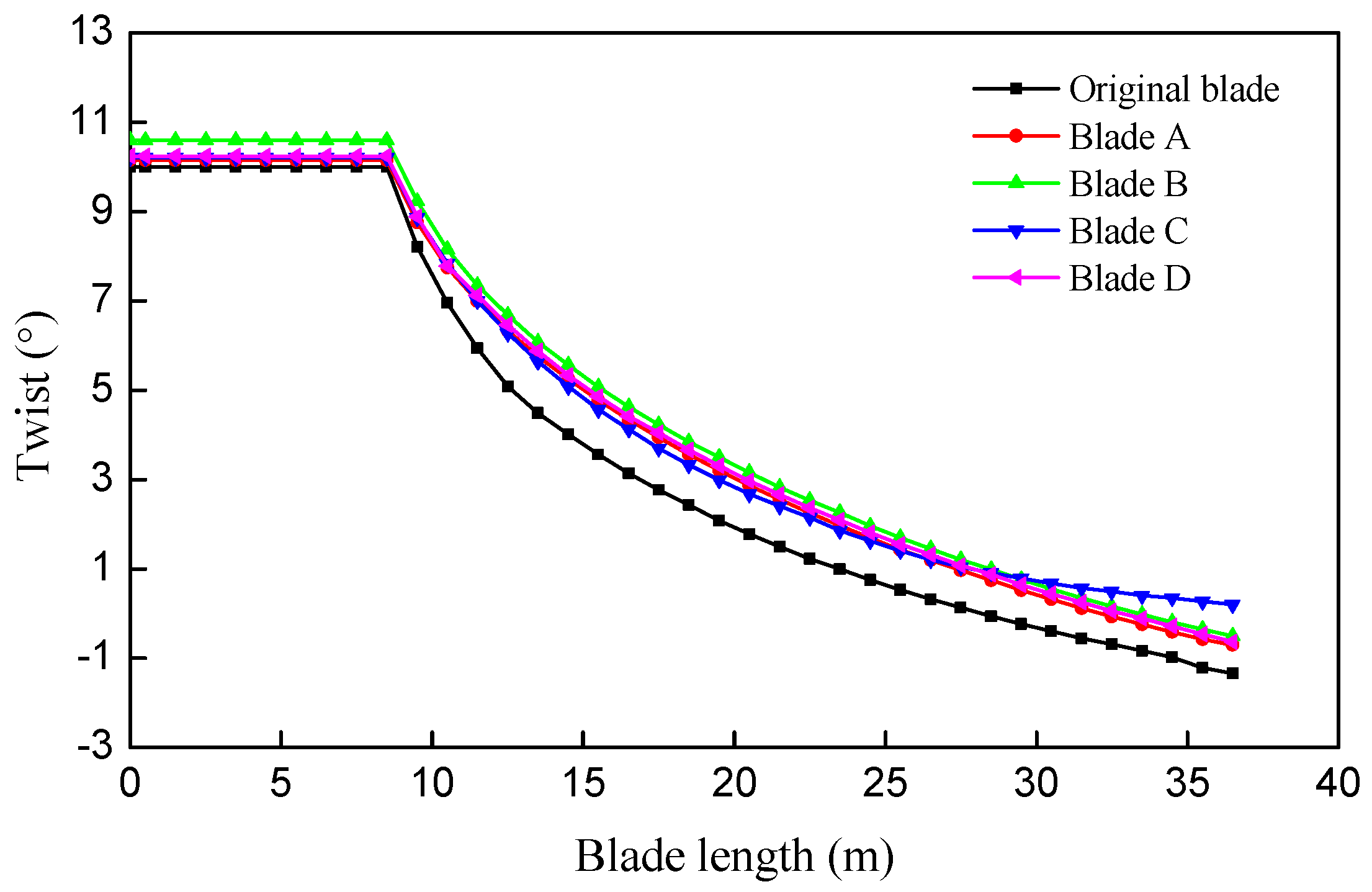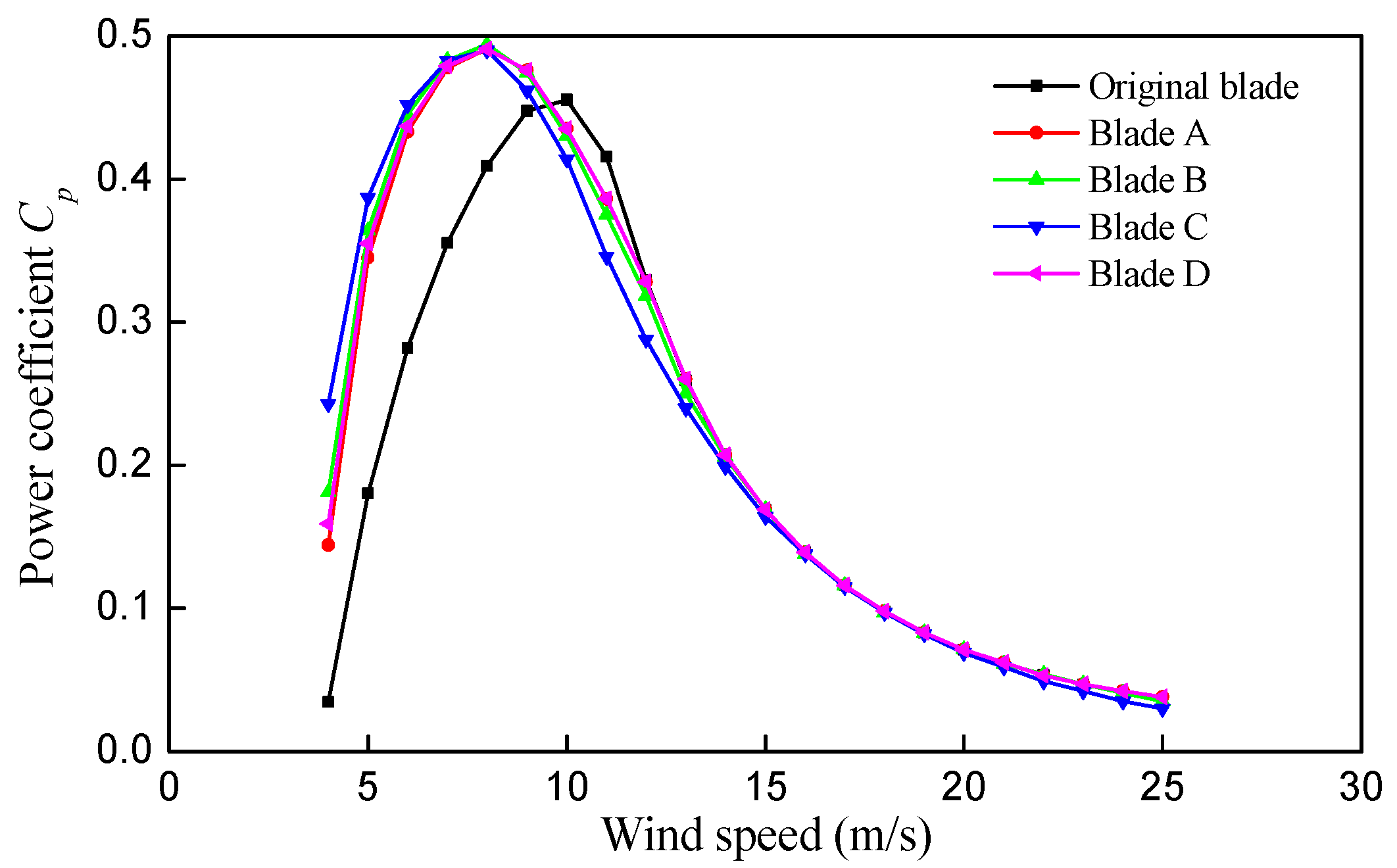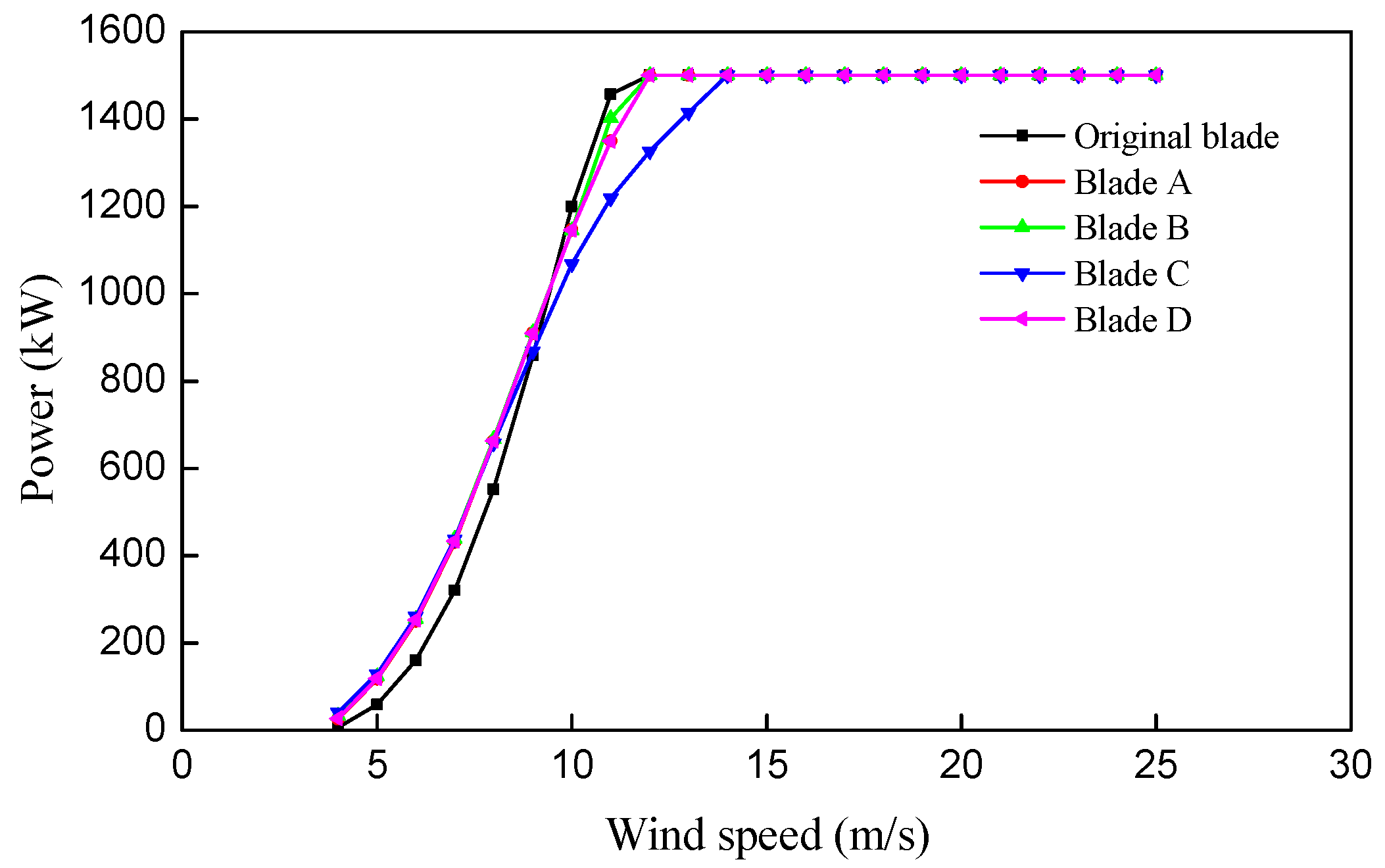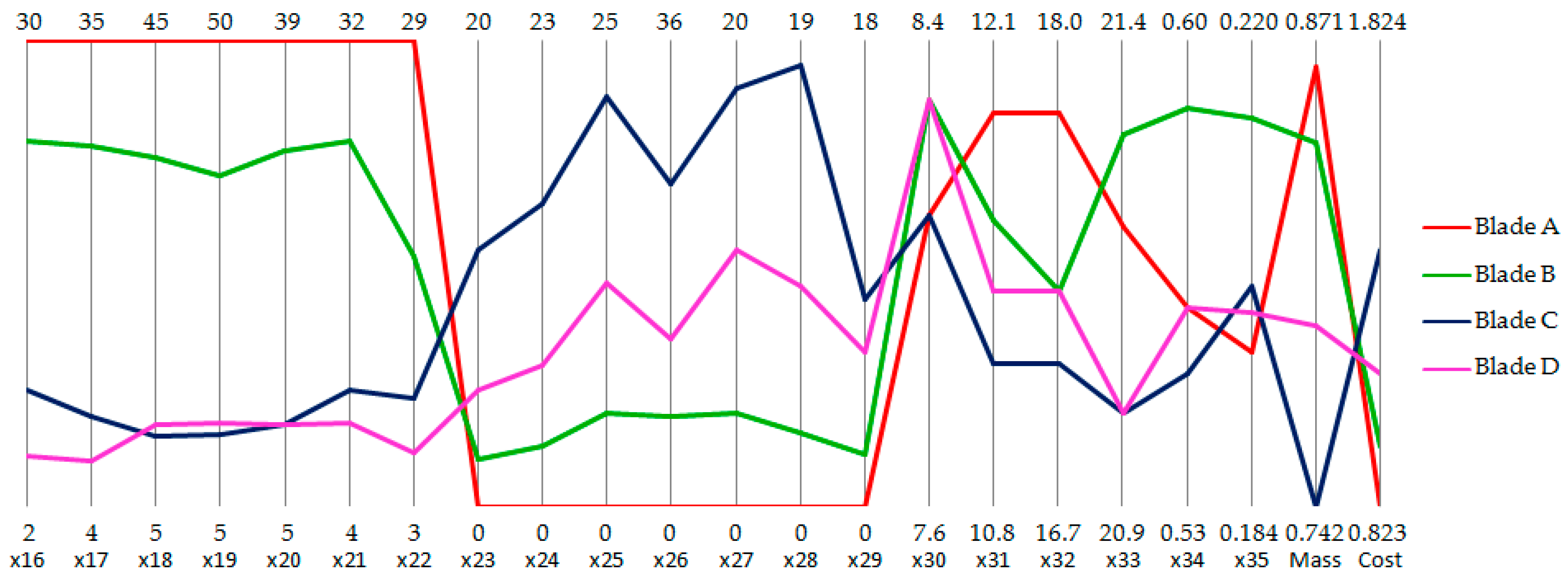5.1. Case Study
A commercial 1.5 MW fixed speed/variable pitch turbine blade with a length of 37 m is applied as a case study. The main geometrical features of the blade are summarized in
Table 2. As the tip region of the blade is mainly designed to reduce the aerodynamic noise caused by the blade interacts with the air flow, which contributes little to the structural performance, so the 0.5 m region at the tip is not considered in this research for convenience. The thickness distributions of the spar cap, leading edge, shear webs and trailing edge are shown in
Figure 9. According to the thickness distributions, 290 real constants are defined through adjusting the model many times. The entire FEM model with a length of 36.5 m and some typical cross sections of the blade are shown in
Figure 10.
Figure 11 shows the load distributions of the FEM model calculated in
Section 2.1, the blade is divided into 36 cross sections every 1 m and the forces are applied on the cross sections as concentrated forces. The flap-wise, edge-wise and torsional rigidities validation process of the FEM model had been carried out in [
19] to guarantee the reliability of the numerical simulation.
The basic parameters of the commercial 1.5 MW blade set in the procedure are listed in
Table 3. The ranges of design variables and the constraint values are listed in
Table 4. The wind condition is derived from a local meteorological data of inland China with an annual average wind speed of 6 m/s, the turbulence parameter is 0.16, the values of Weibull form factor
k and scaling factor
A are calculated to be 1.91 and 6.8, respectively. The basic parameters of NSGA-II algorithm are: the population size is set as 80, the maximum number of generations is 50, and the probabilities of crossover and mutation are taken as 0.8 and 0.05, respectively.
5.2. Results and Discussion
Figure 12 shows the final Pareto front of the airfoil-specific turbine blades derived from the procedure, it illustrates that an improvement on one objective will cause deteriorations on the other one or two objectives, which proves there are some conflicts between the selected objectives. The designer could chose the appropriate design based on specific goals and intentions. The projection of cost and mass reveals the relation of these two objectives is approximately monotonic. The same relation can also be found in the
AEP and mass related Pareto front projection, while the relation of cost and
AEP is rather complex. The extreme point design for each objective function (marked with A, B and C) and a design in the middle of the compromise region (marked with D) have been investigated further to show the properties of the design that lead to improved performances. Blade A has the lowest cost, blade B has the maximum
AEP, and the mass of blade C is the lightest.
Table 5 shows the design variable values and objective values of the original blade and the analyzed four blades.
Figure 13 shows the chord distributions of the original and optimized blades. It can be seen that the chords all decrease after optimization, especially in the maximum chord region and the region close to the tip. As the root diameter is fixed, the chords of the optimized blades change slightly near the root. Although the decrease of chord would cause the power reduction in some degree, it can reduce the amount of materials and the thrust at the same time, which will lead to a lighter and cheaper blade. Because B-Spline curve is used for the chord distribution, the tip shape seems blunt compared with the original blade. However, as the 0.5 m region at the tip is not considered, the chords in this region could be adjusted and modified in the follow-up design process.
Figure 14 shows the twist distributions of the five blades. Because the root and the region near it are mainly design for structural reasons and contribute little to the aerodynamic performances, the twists in these regions are almost unchanged. In the aerodynamic region, the twists all increase after optimization, but the distribution trends almost remain the same with the original blade. The increase of the twists can result in a power increase to some extent, which is just the opposite of the chords reduction. This is because with the decreasing of the rotational speed (listed in
Table 5), the angle between the mean relative velocity and tangential direction will increase. In order to maintain the high lift-to-drag ratios of the airfoils, the twists should also increase to keep the angle of attacks almost the same.
Figure 15 shows the percent thickness distributions of the five blades. The locations of the airfoils with 40% and 30% thicknesses increase (move toward the tip), while the locations of the airfoils with 25% and 18% thicknesses decrease (move toward the root) after optimization. The two thick airfoils move toward the tip means the percent thickness in the transition region increases, which would increase the section moment of inertia from the structural point of view. As the two thin airfoils have higher lift-to-drag ratios, moving their locations toward the root can increase the length of the main part that captures wind energy, which is beneficial to improve the power efficiency from the aerodynamic point of view.
To further find the blade designs with the improvements for the maximum
AEP objective, the parallel coordinates in the design space is applied, as shown in
Figure 16. The comparison reveals that: blade A and C exhibit a high correlation of aerodynamic variables, except for the twist at the tip and the rated rotational speed, which translates to larger twists above the original distribution trends in the main aerodynamic region and a smaller rotational speed for the design with lower
AEP; blade D inherits most of the aerodynamic features from blade A but with a larger aerodynamic region and therefore a higher
AEP; huge differences for most aerodynamic variables between blade B and blades A and C, which means larger chords, twists(with the same distribution trends of original design), the length of the main part that captures wind energy (approximately from the location of the 25% airfoil to the blade tip) and rotational speed are associated with higher
AEP.
The comparison of power coefficients and powers between the five blades are shown in
Figure 17 and
Figure 18. Compared to the original blade, the power coefficients of the optimized blades increase significantly in the speed range of 4 to 9 m/s, then decrease slightly in the range of 10 to 13 m/s, and keep high values (exceed 0.4) in the range of 6 to 10 m/s. Each blade reaches the maximum power coefficient at 8 m/s wind speed, the maximum values all exceed 0.49, increased by more than 7.7% compared to the original blade. The rated wind speeds of the four optimized blades gradually increase from 12 to 14 m/s with the reduction of chords and rotational speed and the increase of twists, as shown in
Figure 18. The comparisons in
Figure 17 and
Figure 18 show that the aerodynamic performances of the optimized blades are significantly improved at low wind speeds and drop a little when the wind speed increases. As the wind condition set in the procedure has much higher probabilities at low wind speeds, so the optimized blades can utilize more wind energy resources and thus to increase the
AEP.
Figure 19 and
Figure 20 show the comparisons of total material layup and GFRP layup in the spar cap between the original blade and optimized blades. It can be seen that the total number of layers and the number of GFRP layers both decrease obviously after optimization, especially in the middle part of the optimization region, while the number of CFRP layers gradually increases, and the region with maximum number of layers becomes smaller. It indicates that the materials in the middle part has greater impact on the blade mass and cost than those in the other parts. As the region close to the tip withstands smaller loads, the number of layers decrease a bit more than that close to the root.
The position of the shear webs increases while the width of the spar cap decrease after optimization, as listed in
Table 5. Moving away from the centerline of the spar cap can decrease the height of the shear webs, and a smaller width of the spar cap can reduce the amount of materials, which are both beneficial for reducing the blade mass and cost.
The parallel coordinates in the design space is applied again to find the blade designs with the improvements for the minimum mass objective and the minimum cost objective, as shown in
Figure 21. The comparison shows that there are obvious differences for most structural variables between the three extreme point designs and the selected compromise design, the biggest differences are the number of material layers. Since CFRP is 10 times expensive than GFRP, more number of CFRP layers results higher cost, especially when the number of GFRP layers, chords and width of the spar cap are almost the same (blade C and D). The number of layers associated with the mass is on the contrary as CFRP is much lighter. On the other hand, because CFRP has higher modulus and tensile strength, its use can tremendously decrease the total number of layers and therefore reduce the cost to some extent, which means the cost of a blade design can be cheaper than the original blade when appropriate amount of GFRP combined with CFRP are applied.
The comparison in terms of the objective function can be found in
Table 5. Compared with the original blade, the
AEP of blades A, B, C and D increase by 10.6%, 12.1%, 6.9% and 11.0%, the blade mass decrease by 13.6%, 15.7%, 25.8% and 20.8%, and the blade cost reduce by 17.7%, 4.7%, −37.6% and −10.9%, respectively.
Table 6 lists the structural behaviors of the original and optimized blades under different load cases. It can be seen that the ultimate load case (case2) has a greater influence on most the structural behaviors, while the operational load case (case1) causes a smaller buckling eigenvalue, which is a result of the action of the normal and tangential forces. With the increase of CFRP layers, the maximum strains in the optimization and non-optimization regions and the tip deflection gradually decrease, the lowest buckling load factor and the first natural frequency increase. All of these are good for improving the blade strength, stiffness and reducing the response of the blade being excited. Since results such as blade B could improve not only the objectives but also the structural behaviors, they seem to be more desirable than the other results by the consideration of the purpose in the present work.
